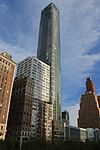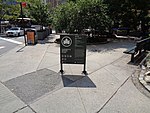21 West Street

21 West Street, also known as Le Rivage Apartments, is a 33-story building located in the Financial District of Lower Manhattan in New York City, on Morris Street between West Street and Washington Street. It was built in 1929–1931 as a speculative office tower development in anticipation of an increased demand for office space in Lower Manhattan. The building was converted into apartments in 1997 and was renamed Le Rivage. The building has an Art Deco design with many lavish architectural finishes and a series of setbacks which taper toward the top floors. It was designed by Starrett & van Vleck, who at the same time designed the adjacent Downtown Athletic Club. 21 West Street was listed on the National Register of Historic Places in 1999 and designated a city landmark by the New York City Landmarks Preservation Commission in 1998.
Excerpt from the Wikipedia article 21 West Street (License: CC BY-SA 3.0, Authors, Images).21 West Street
West Street, New York Manhattan
Geographical coordinates (GPS) Address Website External links Nearby Places Show on map
Geographical coordinates (GPS)
| Latitude | Longitude |
|---|---|
| N 40.706388888889 ° | E -74.015555555556 ° |
Address
Le Rivage
West Street 21
10004 New York, Manhattan
New York, United States
Open on Google Maps







